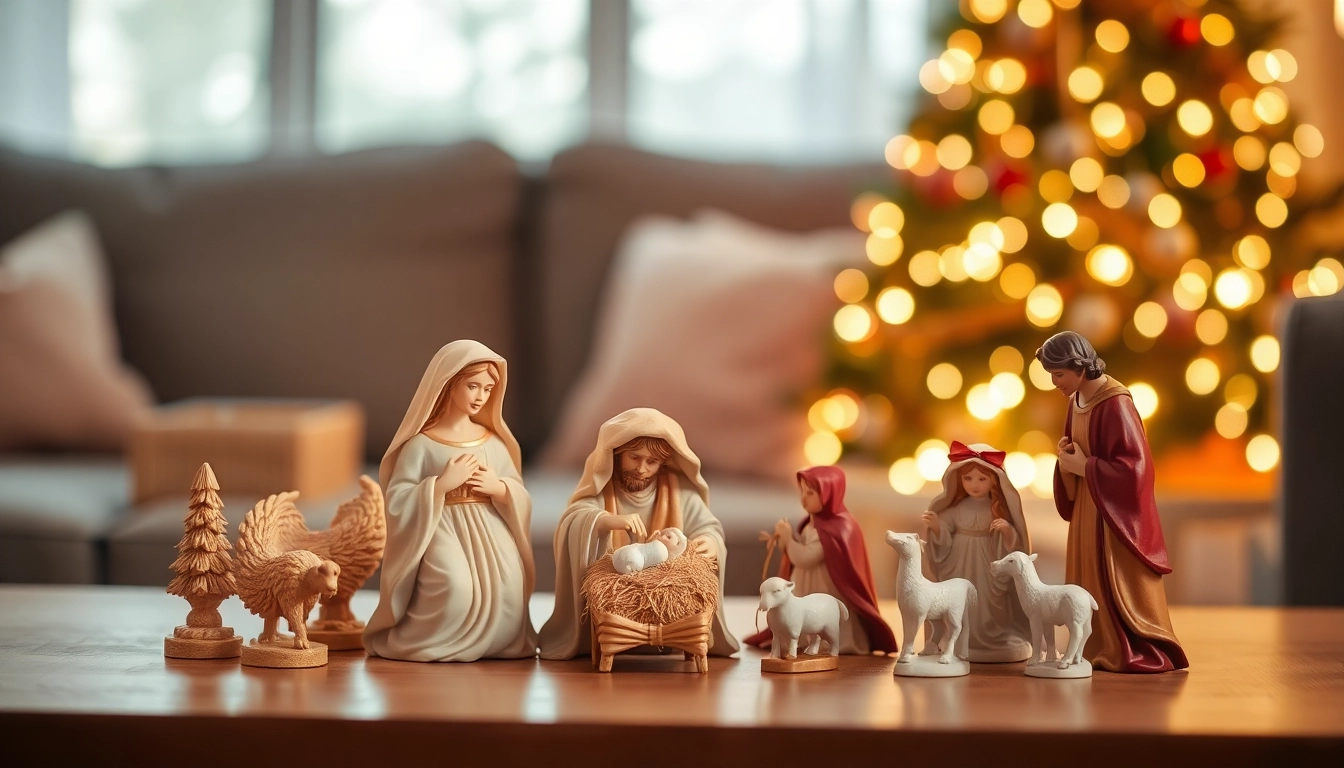Embracing the Spirit of the Holidays with Exquisite Nativity Sets
Introduction to Nativity Sets
As the holiday season approaches, many families around the world prepare to celebrate one of the most cherished traditions in Christianity: the Nativity. Central to this tradition is the Nativity set, a visual representation of the birth of Jesus Christ, often consisting of figures depicting the Holy Family, angels, shepherds, and various animals. A well-crafted Nativity sets can add a touch of beauty, spirituality, and heritage to your home during this festive season. This article delves into the significance, history, materials, selection tips, creative display ideas, maintenance strategies, and cultural impact of Nativity sets.
Understanding Nativity Sets and Their Significance
Nativity sets serve more than just a decorative purpose; they embody deep cultural and spiritual meanings. Originating from the biblical narrative of Jesus’ birth, these sets invite individuals and families to reflect on the themes of hope, humility, and love. Displaying a Nativity set is a way to celebrate faith, history, and familial bonds during the Christmas season. Each figure represents a part of the story, encouraging storytelling traditions as families share the meaning behind each character—Mary, Joseph, the newborn Jesus, and others that come together to form a cohesive narrative that has transcended generations.
The History and Evolution of Nativity Sets
The first recorded Nativity scene was created in 1223 by Saint Francis of Assisi in Greccio, Italy. His portrayal of the Nativity was intended to evoke the emotional experience of Jesus’s birth, making the event more accessible and relatable to the faithful. Over the centuries, this practice evolved, particularly during the Renaissance when artisans created increasingly elaborate and artistic representations. Today, Nativity sets exist in a multitude of styles, reflecting various regional interpretations and artistic preferences, allowing individuals to connect with the story in diverse and meaningful ways.
Common Materials Used in Nativity Sets
Nativity sets can be crafted from a variety of materials, each imparting unique aesthetics and durability. Common materials include:
- Wood: Offers a traditional look and can feature intricate carvings or simple designs. Wood sets are often associated with rustic or handmade styles.
- Resin: A popular option for many sets due to its versatility and ability to be molded into intricate shapes, making it easy to create detailed figures at an affordable price.
- Ceramic: Often used for higher-end sets, ceramics present a classic look, often hand-painted, adding an artistic touch to displays.
- Plastic: This material is common in outdoor sets or larger displays, known for its durability and resistance to weather conditions.
Choosing the Right Nativity Sets for Your Home
Factors to Consider When Selecting Nativity Sets
Choosing a Nativity set that complements your home and resonates with your family can enhance your seasonal celebrations. Here are essential factors to keep in mind:
- Size: Consider where you plan to display your Nativity set. Larger sets can serve as a focal point in living rooms, while smaller sets might fit better on shelves or tabletops.
- Style: Choose a style that aligns with your existing home décor. Whether you prefer rustic wooden designs, elegant ceramics, or contemporary options, the set should harmonize with your space.
- Completeness: Some sets may come with additional figures like animals and shepherds, while others may only depict the Holy Family. Assess your preference for a complete scene versus a minimalist approach.
- Durability: If planning to use the set outdoors, ensure it is made from materials suited for various weather conditions.
Different Styles and Themes of Nativity Sets
Nativity sets come in diverse styles and themes reflecting various artistic traditions worldwide:
- Traditional: Features classic representations of the Holy Family with familiar figures and subdued colors, often made from wood or ceramic.
- Modern: Incorporates abstract or contemporary designs that reinterpret the Nativity story with unique artistic expressions.
- Regional: Represents cultural variations, such as Hispanic or African styles, showcasing local artistry in materials and expressions.
- Children’s sets: Designed for younger audiences, these sets are brightly colored and may feature simplified characters for ease of play and understanding.
Size Considerations for Your Nativity Displays
The size of your Nativity set must align with your intended display area. Consider these aspects:
- Proportions: Ensure the figures are proportionate to your display space. A tiny set might get lost in a large room, while an oversized set could overwhelm a small area.
- Grouping: If you opt for multiple sets or figures, plan your layout to maintain balance. Mixed sizes can create a visually engaging arrangement as long as there’s a unifying theme.
- Accessibility: Ensure the set is displayed at a height that allows for easy viewing and interaction, especially if children will be involved in the display.
Creative Ways to Display Nativity Sets
Indoor Display Ideas for Nativity Sets
Bringing the Nativity indoors allows for creative expression:
- Tabletop Centerpiece: Position the set as a centerpiece on the dining or coffee table to invite conversation and reflection during gatherings.
- Bookshelf Integration: Incorporate the set among books and other memorabilia, creating a narrative path linking the figures with your family’s beliefs and histories.
- Shadow Boxes: Display the Nativity in a shadow box for a three-dimensional effect, enhancing its visual appeal while protecting the figures from dust.
Outdoor Display Options for Nativity Sets
An outdoor Nativity display can be a joyful beacon for neighbors and community members:
- Front Yard Setup: A well-lit outdoor display can serve as an inviting focal point for passersby, enhancing the festive spirit within your neighborhood.
- Porch Arrangements: Position a set on your front porch to welcome guests with a spirit of warmth and hospitality.
- Community Displays: Collaborate with local community groups to create larger displays in communal spaces, amplifying the message of hope and unity during the holidays.
Seasonal Arrangements Around Nativity Sets
Enhancing your Nativity set with seasonal decorations can create a more festive ambiance. Consider using:
- Lights: Use soft lighting around the set to create a serene atmosphere, emphasizing its significance.
- Floral Arrangements: Surround the Nativity set with seasonal greens and flowers to incorporate natural beauty and color.
- Soft Fabrics: Place fabrics like velvet or silk to contrast with the figures and add texture to the display.
Maintaining and Caring for Your Nativity Sets
Cleaning Tips for Various Materials in Nativity Sets
Proper care ensures that your Nativity set remains pristine for years. Different materials require varying maintenance:
- Wood: Dust regularly using a soft cloth. Avoid excess moisture, and consider treating it with a wood conditioner to keep the finish vibrant.
- Resin: Clean with a damp cloth and avoid harsh chemicals that can damage the paint. For stubborn dirt, warm soapy water may be used gently.
- Ceramic: Hand wash with a soft sponge; avoid abrasive cleaners that could scratch the surface.
- Plastic: Wipe down with a damp cloth and use mild soap for tougher residue, as it is typically easy to maintain.
Storage Solutions to Protect Your Nativity Sets
When not in use, proper storage is crucial for preservation. Here are tips:
- Original Packaging: Whenever possible, store figures in their original packaging to prevent damage.
- Individual Boxes: For sets without original packaging, use individual boxes lined with soft material to prevent scratching and breakage.
- Climate Control: Store in a climate-controlled environment to avoid issues with humidity and temperature fluctuations that could damage materials.
Restoration Options for Damaged Nativity Sets
Accidental damage is common, but restoration can often be achieved:
- Minor Repairs: Use glue or clay for small breaks or chips. Ensure materials are compatible with the original substance for a seamless repair.
- Painting Touch-Ups: For chips in paint, use acrylic paint to touch-up minor blemishes, matching the original color as closely as possible.
- Professional Restoration: If damage is extensive, consider consulting an art restoration specialist who can provide professional repairs and advice.
The Cultural Impact of Nativity Sets
Nativity Sets in Different Cultures Around the World
Nativity sets are not just confined to Christianity but have permeated various cultures worldwide, adapting to local customs and artistry:
- Latin America: Often features vibrant colors and local figures; many sets incorporate regional flora and fauna.
- Italian: Known for intricate details and craftsmanship, with many families creating their Nativity scenes from scratch, often passed down through generations.
- Middle Eastern: Reflect authentically-inspired elements with more historical figures that resonate with local heritage and artistry.
The Role of Nativity Sets in Modern Celebrations
In contemporary settings, Nativity sets continue to play a vital role in enhancing the meaning of Christmas. Many families use them as educational tools to teach children about the biblical story, encouraging family traditions around the Nativity scene each year. The discussion spurred by these displays can strengthen familial and community bonds, helping younger generations understand their cultural and religious roots.
Collecting Nativity Sets as a Cultural Tradition
For many, collecting Nativity sets has become a beloved tradition, combining art appreciation with familial storytelling. Collectors often seek unique styles from various cultures, creating a diverse array that reflects personal heritage and beliefs. This passion can serve not only as a means of individual expression but also foster connections with fellow collectors, enriching one’s understanding of this timeless tradition.











Post Comment